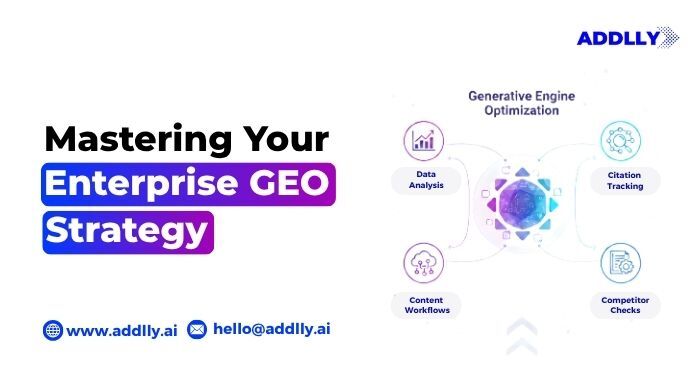An Enterprise GEO strategy brings order to a noisy digital marketing landscape. Traditional search engines still matter, yet AI powered search experiences now influence what people read and trust. Google AI Overviews, Meta AI, ChatGPT style answers, and other major AI platforms reshape click paths and attention.
The goal is simple. Make your enterprise brand appear as a cited source inside AI generated responses, while protecting organic visibility in classic search results.
Quick Summary – How To Master Enterprise GEO
Enterprise GEO helps enterprises show up inside AI answers while protecting organic search. The focus and differences are simple:
- SEO builds crawlability and depth. GEO earns citations in AI summaries and answers.
- Use structured data, clear entities, and concise answer blocks on high value pages.
- Track citation share, answer coverage, quoted text accuracy, and organic traffic.
- Run competitor checks to see who appears in AI responses for your priority topics.
- Treat AI visibility like a product metric. Ship small changes, measure, and scale.
Winning here calls for an integrated approach. Together, they improve brand visibility across both organic search results and AI generated answers.
Generative Engine Optimization (GEO) Explained
GEO helps align your site, content, and data with how AI engines build answers. These engines use generative AI models that read pages, schemas, tables, PDFs, and feeds. They prefer clear entities, consistent facts, and natural language that maps to user intent and user queries.
Core ideas to apply at enterprise level:
- Treat every high value page as a data source for AI engines
- Use structured data to define entities, claims, and relationships
- Write answer first sections that match how AI responses are composed
- Keep product, pricing, availability, and policy facts consistent across surfaces
- Track where your brand is cited inside AI summaries and AI answers
Traditional SEO strategies like keyword research and internal linking still help. GEO adds coverage for AI search engines, answer formatting, and citation visibility.
How Do Enterprise GEO Platforms Help
An enterprise GEO platform like Addlly AI supports operations at scale. It gives one place to track AI visibility, citations, search behavior, and optimization opportunities across markets and languages. Look for capabilities that serve enterprise teams and enterprise clients who need governance and repeatable workflows.
What to expect from a strong enterprise GEO platform
- Source of truth for AI search results and AI generated responses that mention your brand
- Real time tracking on brand mentions, citation placement, and visibility share
- Actionable insights that connect content optimization to performance shifts
- Competitor benchmarking that shows who wins citations on key topics
- API or export to feed dashboards, BI tools, and sales operations
Quick Comparison of GEO vs SEO
| Need | Traditional SEO stack | Enterprise GEO platform |
|---|---|---|
| Primary outcome | Rankings in traditional search | Citations in AI generated answers and AI summaries |
| Data focus | Keywords, links, technical crawl | Entities, claims, structured data, answer snippets |
| KPI examples | Rankings, CTR, organic visits | Brand appears in AI Overviews, citation share, answer coverage |
| Workflow | Page by page optimization | Topic systems, entity catalogs, answer testing at enterprise scale |
| Time horizon | Weekly to quarterly | Weekly to daily with real time tracking |
GEO Strategies that Work
A practical enterprise GEO strategy blends integrated SEO with answer focused content. The steps below scale across regions and product lines.
1. Map topics, entities, and intents
- Build a topic tree from business goals and traffic sources
- Define entities for products, services, people, locations, and policies
- Collect common user queries and long tail variations from support, search data, and ai chatbots
- Record preferred facts, numbers, and terms to keep outputs consistent
2. Structure the facts
- Add structured data for products, FAQs, ratings, pricing, events, and how to content
- Use tables, bullets, and short paragraphs so generative engines can lift clean snippets
- Keep numbers and names in one source of truth to reduce drift
3. Write answer first content
Open with a short summary that answers the core question. Follow with sections that explain why and how, then add step-by-step instructions. Remember to use natural language and avoid fillers. You should also update existing content to include concise answers, schema, and internal links that support entity relationships.
4. Test for AI answers
- Prompt AI engines with your target queries
- Check if your brand appears in the AI response
- Log AI engine citations, position in the answer, and quoted text
- Compare with competitor benchmarking to see who is gaining share
5. Fix technical SEO issues that block AI models
Simple site problems still hurt. Slow pages, blocked resources, duplicate paths, and inconsistent canonicals reduce organic visibility and lower trust for generative ai models. Clean site health supports both traditional search and AI engines.
6. Track AI search performance like a product
Treat AI visibility as a product metric. Ship small changes, monitor shifts, and scale what works across templates and markets.
Read our guide on: Role of E-E-A-T in Generative Engine Optimization (GEO)
Combining Search Engines and AI Search Results
Search engines now mix traditional search results with AI generated content. Google AI Overviews may pull a direct answer with source citations above the fold, so users often read the summary first. They only click when they want depth or proof.
This means brands should plan for both:
- For traditional search, keep strong title tags, meta descriptions, and content depth
- For AI search, format clear facts, add structured data, and write answer blocks that can be quoted cleanly
- For both, maintain consistent claims across pages and feeds
What a Healthy Mix Can Look Like
| Surface | What the user sees | What to optimize |
|---|---|---|
| Traditional search results | Ten blue links, images, and rich results | Technical health, content depth, internal links |
| AI Overviews and other AI responses | Summary with citations and short snippets | Answer blocks, schema, entity clarity, fact consistency |
Start Running Content Optimization and Competitor Benchmarking
Content optimization for GEO means writing for people while feeding AI engines clean data. The aim is not more words, but clearer answers and stronger evidence.
Steps to raise quality:
- Align each page to one main user intent and a set of related questions
- Lead with a short direct answer, then deliver supporting detail with headings
- Use tables for specs, comparisons, and pricing
- Add FAQs that mirror real questions from your support and sales teams
- Cite original research, case numbers, and policies where relevant
Run competitor benchmarking monthly and track which domains appear in AI answers for priority queries. Note patterns in structured data usage, source freshness, and content structure. Use that data to guide your optimization strategies and spot competitive advantages.
Read more on: How to Build Brand Authority to Increase AI Visibility
How AI Visibility Affects Digital Presence, Lead Quality, and Sales Operations
Better AI visibility improves early discovery and mid funnel education. Leads arrive with higher context when your claims already appear in AI summaries, reducing time to value for sales operations.
How to map GEO work with real world outcomes:
- Map AI citation share to lead quality metrics
- Tie page level changes to demo requests and assisted revenue
- Share weekly summaries with marketing, product, and success teams
A data driven approach like the one above keeps everyone focused on business goals rather than vanity just metrics.
From Traffic Sources to Business Goals
Different traffic sources play different roles in an enterprise level plan. Organic search drives steady intent, while AI search can speed education and brand trust when your brand appears as a cited source. Paid media, on the other hand, fills gaps and fuels testing. Social brings reach and community signals that often feed AI engines.
| Goal | Traffic sources to develop | Measures that matter |
|---|---|---|
| Grow qualified pipeline | Organic search, AI search, partner referrals | Citation share, form completes, SQL rate |
| Defend category terms | Organic search, AI Overviews, owned media | Share of voice on priority topics, entity coverage |
| Launch new product | AI search, paid search, social, PR | Time to first citation, assisted conversions |
| Expand globally | Local organic, local AI engines, marketplaces | Localized entity accuracy, local citation share |
How Addlly AI automates the Enterprise Workflow
Alternatively, tools like Addlly AI’s GEO Audit Tool turn the monthly checklist into a clean single workflow you can run at scale. Each step maps to a specific agent, task, and output, so your team can move from ideas to measurable gains without busywork. They can run queries, update entities, ship drafts, test AI answers, and track citations all in one place with zero prompting.
Final Words
An Enterprise GEO strategy is not a side project. It is an integrated approach that shapes how AI engines read your brand, quote your claims, and guide users to your pages. Build clean facts, answer first content, and consistent structure. Then test weekly, track citations and try to improve what your users and AI engines both value. That is how you create content that wins in traditional search and inside AI generated answers.
FAQs – Enterprise GEO Strategy
What is Enterprise GEO?
Enterprise GEO, or Generative Engine Optimization, helps large brands appear as cited sources in AI-generated answers. It aligns website content, structured data, and entities with how AI engines read and summarize information, ensuring your business is visible across both traditional search results and AI-powered experiences.
How is Enterprise GEO Different from SEO?
SEO improves rankings in traditional search engines, while Enterprise GEO focuses on visibility inside AI-generated responses. SEO targets keywords and links, GEO optimizes entities, facts, and answer formatting. Together, they help your brand earn both top search positions and credible citations in AI summaries across digital platforms.
Why Ranking in AI Overviews Matters for Businesses?
Ranking in AI Overviews builds brand trust and early awareness. When your business appears in AI-generated summaries, users see your content first, often before clicking links. This boosts credibility, drives qualified traffic, and increases conversions by positioning your brand as an authoritative, verified source in the new search landscape.
How Can Enterprises Measure GEO Performance and Citation Share?
Enterprises can measure GEO performance by tracking where their brand appears in AI answers, citation frequency, and visibility share. Tools like Addlly AI provide real-time dashboards for monitoring brand mentions, AI overview placements, and competitor performance, helping teams link optimization actions directly to measurable visibility and engagement outcomes.

